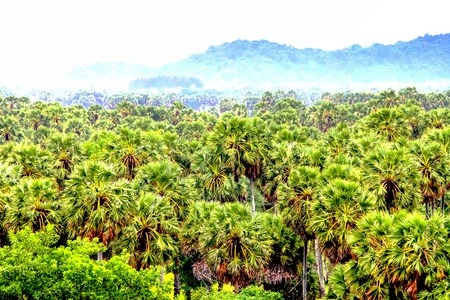
The Palmyra palm (Borassus flabellifer L.) is a tree of great versatility and economically important. The sap or exudate when tapped is turned into a natural sugar sweetener or bioethanol.
The genus Borassus in the Palm family is made up of four species of palm which are found from west Africa to east Indonesia. The palm prefers tropical wet climates. The palm B. flabellifer is the most widely grown from the economic point of view because it provides fibrous building and cleaning materials for brushes etc. (Davis and Johnson, 1987).
A palm sugar for food use can be manufactured from the palm juice by evaporation into a syrup or crystallized into a palm sugar called jaggery in Hindi (Rao et al., 2009). The juice is also the base material for fermentation into an infamous palm wine (Jirovetz et al., 2001) using Saccharomyces species. The sap starts fermenting as soon as it is tapped. Toddy is also prepared from the plant sap as a rough grade beverage because it contains natural yeasts which is mixed with fruit juice to improve its sensory appeal. The Toddy is also used as a leavening agent because of this live yeast content, for bread making and in ‘appam’ which is a pancake made with rice flour (Davis and Johnson, 1987). The sap can also be turned into bioethanol.
The Palmyra Palm in ayurvedic medicine is said to be a stimulant, diuretic, an anti-leprotic (i.e. leprosy treatment), and also have ‘antiphlogistic’ properties although its not clear what the active agents are. The fruit is claimed to act as a digestive agent with sedative and laxative properties too.
The juice also has reputed anti-inflammatory benefits (Nadkarni 1954; Vaidyaratnam, 1994; Kapoor, 2000) and immunosuppressant properties (Revesz et al., 1999). An ethanolic extract of male flowers (inflorescences) produced anti-inflammatory activity in rodents (Paschapur et al., 2009). The nutritional profile for the juice consists of sugars, various proteins, lipids, vitamin A, a B-complex, vitamin C and others minerals (Barh et al., 2008).
SugaVida™ is a natural sweetener for use in beverages which is has a strong claim to offer vitamin B12 (cobalamin) as an alternative option to animal derived sources. That makes it suitable for vegan and children’s diets. The suppliers, Conscious Foods Ltd. state one tablespoon provides 133% of the RDA for vitamin B1 as well as 222% of the RDA for vitamin B6 (pyridoxine) and 664% of the RDA for vitamin B1. It is also versatile in its use – as a low GI and diabetic ingredient and can be added to beverages or used in baking (hinting at its heat resistance). It is available in a 250g tin and only 50% of the amount of sucrose is needed in applications.
References
Barh, D. and Mazumdar, B. C. (2008) Comparative Nutritive Values of Palm Saps Before and after Their Partial Fermentation and Effective Use of Wild Date (Phoenix sylvestris Roxb.) Sap in Treatment of Anemia. Res. J. Medicine and Science 3(2) pp. 173-176.
Davis, T. A., & Johnson, D. V. (1987). Current utilization and further development of the palmyra palm (Borassus flabellifer L., Arecaceae) in Tamil Nadu State, India. Economic Botany, 41(2), pp. 247-266.
Jagannadha Rao, P.V.K., Das, M., & Das, S. K. (2009). Changes in physical and thermo-physical properties of sugarcane, palmyra-palm and date-palm juices at different concentration of sugar. J. Food Eng., 90(4), pp. 559-566.
Jirovetz, L., Buchbauer, G., Fleischhacker, W. and Ngassoum, M. B. (2001) Analysis of the aroma compounds of two different palm wine species (‘Matango and Raffia’) from Cameroon using SPMEGC- FID, SPME-GC-MS & olfactometry. Ernahrung/Nutrition pp. 67-71.
Kapoor, L. D. 2000. Handbook of Ayurvedic medicinal plants: Herbal reference library. CRC Press, p 82, USA, Florida.
Nadkarni, K. M. 1954. Indian Materia Medica, Ed 3rd, Vol. 4, p 2571-2575, Popular Book Dept, Bombay, India.
Paschapur, M. S., Patil, M. B., Kumar, R. and Patil, S. R. 2009. Evaluation of anti-inflammatory activity of ethanolic extract of Borassus flabellifer L. male flowers (inflorescences) in experimental animals. J. Medicinal Plants Res. 3(2): pp. 49-54
https://academicjournals.org/journal/JMPR/article-abstract/22525D714678
Rao, P. V. K. J., Das, M. and Das, S. K. (2009) Changes in physical and thermo-physical properties of sugarcane, palmyra-palm and date-palm juices at different concentration of sugar. J. Food Eng. 90 pp. 559–566
Revesz, L., Hiestand, P., La Vecchia, L., Naef, R., Naegeli, H.U. and Oberer, L. (1999) Isolation and synthesis of a novel immunosuppressive 17 alpha-substituted dammarane from the flour of the Palmyrah palm (Borassus flabellifer). Bioorganic and Medicinal Chemistry Letters 9 pp. 1521-1526.
Vaidyaratnam, P. S. 1994, Reprint 2002. Variers Arya Vaidya Sala – Indian Medicinal Plants, A Compendium of 500 species, Vol. 4, p. 293-296, Orient Longman: Chennai, India.
Leave a Reply